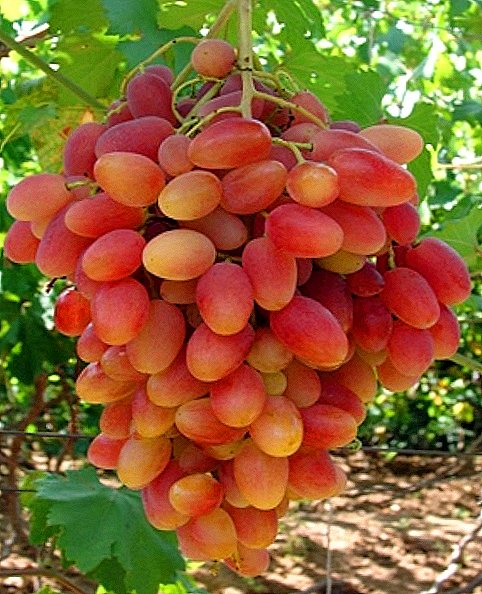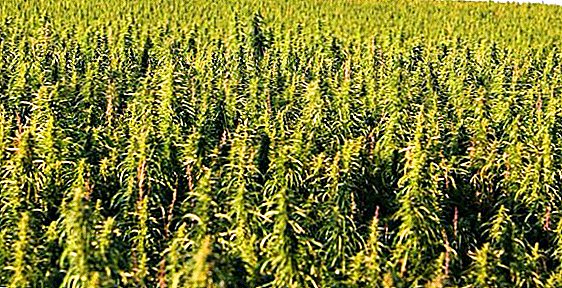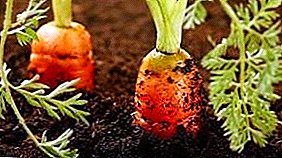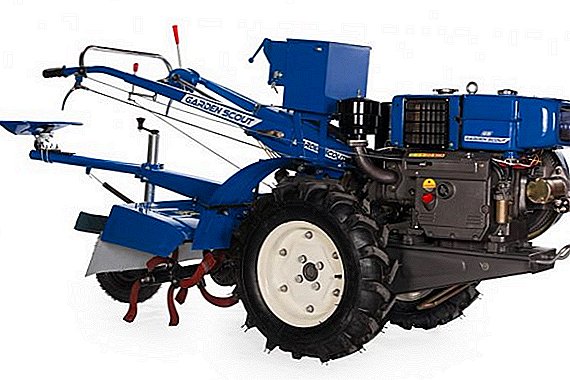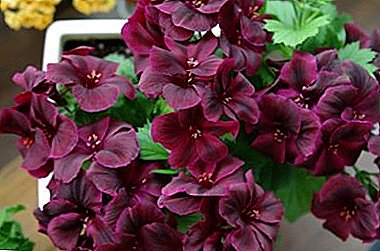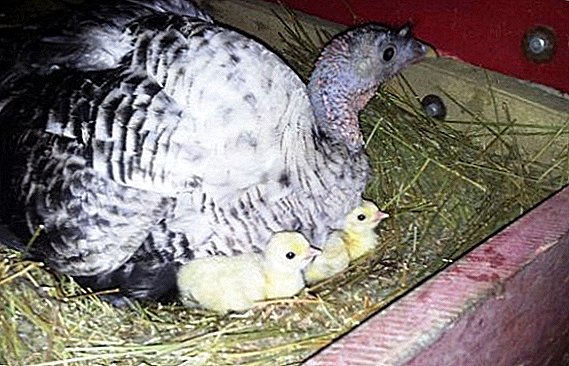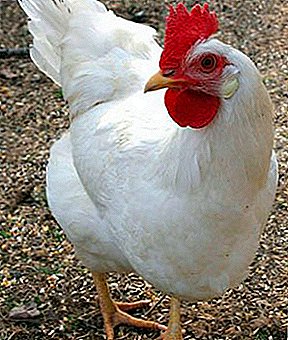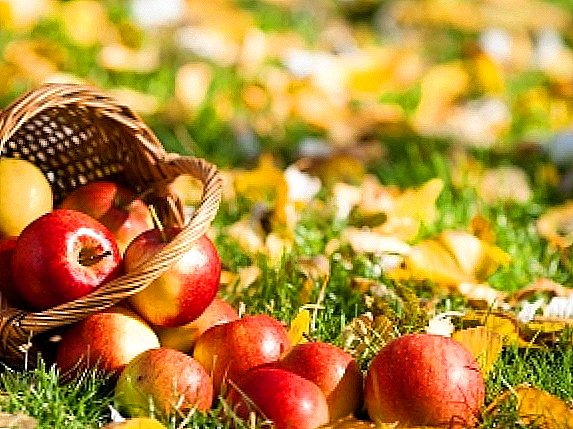
In your garden, it is very important to have apples of different ripening periods in order to feast on fresh fruits all year round.
Today we have very carefully approached the lighting of autumn varieties of apple trees, their features, advantages and disadvantages.
Pay attention to the basic requirements for the care of this type of trees and especially planting seedlings.
The most famous varieties of autumn apple trees
Autumn apple varieties differ special taste and enough long storage period fruits. In particular, apples ripen around early to mid-September.
Fruit is recommended self-shoot from the treewithout waiting for them to fall. The full maturity of apples comes only 15 days after their removal from the tree. Fruits of autumn apple varieties are stored until early January.
Macintosh apple variety

Despite the fact that this variety, bred in Canada, historically applies to winter varieties, in the southern climatic regions of Ukraine and Russia, its fruits ripen in early September. We now turn to a detailed description of the variety of apple trees "Mac".
By size apples are above average or average. The upper part of the fruit is weak in shape, and the lower part is divided into "slices". The peel of the apple is smooth, covered with a small layer of wax coating, rather dense in structure, capable of easily separating from the pulp. The main color is whitish yellow, sometimes greenish yellow. Most of the fruit is covered with a cover of dark purple stripes on a reddish background.
Pulp color ripe apple white, characteristic red streaks sometimes appear. Differs juiciness and tenderness of taste, which is sweet and sour. Also, the taste has a characteristic candy spice. The amount of ascorbic acid, which is included in the chemical composition of the pulp, is 3.8 mg / 100 grams.
The tree belongs to vigorous. Branchy branches, skeletal, which form a thin but strongly scattered crown. Tree is characterized mixed type of fruiting.
Macintosh varieties are good for growing for sale. After all, their main advantages are great appearance and distinctive taste qualities who like many.
Also, ripe fruits without difficulty may persist for a long time. Apples are subject to transportation. High yield on clonal rootstocks.
Despite the fact that in general yield varieties enough highhowever, if your tree is grafted on a seed stock, you run the risk of crop irregularity. Also, there is a risk of losing the crop if it is not harvested from the tree in time: the apples themselves will fall off, and in rainy weather they may rot from high moisture.
The variety is poorly resistant to low temperatures and to diseases (often affected by scab).
Apple variety "Pepin Saffron"

This variety can also be called winter. Apples "Pepin Saffron" ripen only by the end of September, the beginning of October. But all the variety is very common in Russia, Ukraine and other countries of the same latitude. "Pepin Saffron" is the result of the crossing of the variety "Renet Orleans" with the hybrid varieties "Pepinka Lithuanian" and "Kitayka".
Fruits are medium or not at all big. Fruit symmetrical in shaperounded conical. On some fruits, slight ribbing may be noticeable. The peel is smooth, but tuberosity may occur near the calyx.
Characterized by subcutaneous points, which are a great many apples of this variety. The color of the fruit has a greenish-yellow hue. The main color is covered with a red "blush" with reddish stripes shading.
The color of the pulp - cream. By structure, it is quite dense and juicy. Taste characterized as sweet wine with a special spicy aroma. The content of ascorbic acid in the pulp is 14.2 mg per 100 grams of pulp.
Now the description of the apple tree "Pepin Saffron"
Tree srednerosly. Behind the crown shape of a young tree, it can be called rounded, but with the onset of abundant fruiting, the branches descend, making it wide-round. Crown highly thicktherefore requires careful maintenance and regular thinning. Growth shoots are fruitful at the Pepin Saffron tree.
Fruit Surprise with its high suitability for transportation. Shelf life makes up about 223 daysthat makes it possible to use their fruits even in February and March, that is, 5-6 months after breaking off from the tree.
They can be used for sale (attractive coloring), and for technical processing, home preservation of various kinds. The special taste is different jam from the fruit "Pepin Saffron."
Tree is hasty - Yields can be harvested as early as 5-6 years after planting the seedling. Harvests are regular and quite abundant. Self-fruited variety. It has a high regenerative capacity, which makes it possible to do pruning every year.
But there are also disadvantages. Tree strong needs care, especially in pruning, because without it fruits become very small, the general productivity decreases. Fruits and leaves of the grade "Pepin Saffron" prone to fungal infectionsIn particular scab. The danger is the apple moth. Resistance to low temperatures is average. Fruits are prone to shattering.
Apple variety "Pepinka Lithuanian"

This variety actually has a lot of names, among which is “Glogerovka”, simply “Pepinka”, “Sarepka” and “Pepin Lithuanian”. It is the result of folk selection, is of Baltic origin. Despite the fact that it does not have a large distribution in industrial gardens, it is particularly popular with the population.
The size of the fruit is averagedecreases with increasing yield. Barrel-shaped, slightly rounded. The largest diameter of a ripe apple in the middle of the fruit. Ribling is not typical. Color is light yellowIt can sometimes be straw white. Cover in the form of "blush", the color of pink and carmine, blurred.
Pulp in ripe fruit white. It contains a lot of juice, the structure is fine-grained. Taste is gentle, sweet-sour.. Tastes are highly appreciated by experts, also thanks to the special aroma of apples.
The tree belongs to the middle. Grows rapidly and enters fruiting. The krone is very thick. Branches drooping, constantly overgrown. A distinctive feature of the tree can be called the tortuosity and undulation of skeletal branches and conductors.
Important quality varieties are small size of the tree. Due to this, the care of him and the gathering of fruits cease to be a super task. The variety is skoroplodny, high yields can give even at a young age. The advantage is the high taste qualities of apples. Subject to use as in a reduced form, and in the form of juices, dried fruits, peeled form.
Shelf life is long, until January.
The main disadvantage of the tree is its low resistance to winter frosts and disease (scab). Fruits are not large enough, are not presentable in the sale. Fruiting with age of the tree may become irregular.
Grade apples "Glory to the Victors"

Another autumn variety, which is the result of the selection of Ukrainian scientists. His parents are the Papirovka varieties and the Macintosh variety noted above.
Let us turn to the description of the fruit of the apple.
Dimensions fruits can be as large (up to 150 grams) and average - depending on the external weather conditions of the current year. Also, a positive effect on the size of the fruit affects the tinned soil and the optimum state of soil moisture and air.
The form ripe apples oblong-round. Some fruits may be weakly conical, with a slight ribbing. The skin is smooth, with a characteristic wax coating. Characterized by a large number of subcutaneous points.
The color of the ripe fruit is light green. Cover color covers almost the entire fruit, blurry, reddish hue.
Pulp fruits white color with a touch of cream. Taste is very high because the fruits characteristic juiciness, tenderness and sweet-sour aromatic taste.
For the chemical composition of the fruit richly rich in beneficial vitamins. The amount of ascorbic acid is 8 mg per 100 grams of pulp.
The strong-growing apple tree of the "Glory to the Victors" variety has broad crown shape. With age and with an increase in yield, the form becomes highly rounded. The branches depart from the trunk at an acute angle, but after a while they gradually descend.
Under favorable conditions and soil fertility, even two-year-old wood may enter fruiting, but age is considered the norm for this class to be 4-5 years.
Sort highly fruitful and frost resistant. The quality of the taste and appearance of the fruit is high (marketability is up to 90%). The fruits can ripen even before the onset of September. Apples do not fall off even at their maturity. Resistant to scab. Fruits easily carry transportation.
Sort poorly tolerated droughtwhat the crop suffers from, the fruits are showered. It is very exacting to careful and regular leaving, depression of krone. With age and a decrease in soil fertility, fruiting may become irregular.
Variety of apples "Welsey"

The mother of this variety is the Siberian apple-cherry tree. It was bred by American scientists. The variety takes root easily and well bears fruit even in the northern regions of Russia.
Let us turn to the description of the fruit of the apple.
Fruits ripen in mid-September. Their size is mostly average, in form they resemble a turnip a bit. The skin is smooth, with a large number of subcutaneous points. The color of ripe fruit is yellowish-green, acquires a golden hue. The cover is dirty reddish with dark red stripes.
Green or white color of pulp mixed with red veins. Taste sweet and sourIt has a delicate pleasant aroma. However, the quality of taste directly depends on the good weather and soil fertility.
The pulp per 100 grams contains up to 10.2 mg of ascorbic acid.
Apple Tree "Welsey": variety description
Medium tree with wide crown. With the onset of fruiting, the crown is rounded. The branches depart from the trunk to the top, but the ends are slightly lowered. Abundant yields can cause breaking even the largest branches. Fruit tree on the mixed type.
The grade is very quickly comes into fruition (4-5 years). The yield (up to 275 kg from one tree) and resistance to fungal diseases are high. Is different excellent taste, fruits are used both fresh and in the form of juices.
The variety is not resistant to low temperatures, requires special care before the onset of winter. From the abundance of crops lost weight and size of the fruit. Taste depends on the favorable external conditions.
It is also interesting to read about the care of columnar apple trees.
How to care for autumn varieties of apple trees?
Caring correctly: pruning
Pruning autumn apple varieties should be regular. Young seedlings are shortened by 40 centimeters. It is important to cut those branches that will interfere or enter into competition with the conductor. For the correct formation of the crown, it is important to cut those branches that grow inward.
Fertilizer features
In the early years of growth, the sapling is particularly susceptible to various pests and requires nitrogen fertilizer. The dose should be about 50 kg of fertilizer per 1 ha. Half of this dose is given before flowering, the second - 2-3 weeks after.
Proper watering is very important for a good harvest.
The need for watering is only in seedlings immediately after planting. Also, special attention should be paid to dwarf trees, since their roots are close to the soil surface and may not reach the water from the soil on their own.
It is important to take into account that apple trees love the soil with good drainage, so sometimes the trees do not need to be watered, but rather to divert water into specially dug grooves.
However, in dry years it is necessary to water the tree thoroughly, pouring water into special moats around the trunk of the tree. To preserve moisture you can put peat or humus on top.
How to care for a tree in winter
Most apple varieties are resistant to frost, but excessive vigilance does not hurt. Before the onset of cold weather, a tree trunk should be mulched with peat and humus.
The layer must be coarse enough to prevent the soil from freezing around the tree. In winter, with heavy snowfalls, snow is also wrapped around the near-canopy circle. However, with the onset of a thaw, one should make sure that there is no ice crust on top, which will impede the flow of oxygen to the roots.
Carefully follow the winter seedlings. They should be tied up to special stakes, which will protect them from frost winds.
In winter, apple trees can become a victim of various rodents and hares, therefore trunking is recommended to the lower branches.
Planting Autumn Apple Seedlings
Choose the right time
The best time to plant seedlings autumn apple is autumn. However, you need to take into account the weather conditions of each year, and plant a tree two weeks before the frost.
This is necessary so that the tree did not start to revive and germinate earlier, because in this case it can very easily be damaged by frost. If you want to plant apple trees in the spring - wait about half a week after the soil has completely moved away from the frost.
What are the soil requirements?
The best soil for apple trees are loams with a lot of humus.
Also, apple trees are very demanding of soil moisture and fear high levels of groundwater. To grow a good fertile tree on the sands and clay-sandy soils will have to work very hard on their fertilizer.
We proceed directly to the landing
Bookmark garden will be the envy of what size has a tree. If it is medium, then the distance between the trees of one row should be at least 2 meters, and for tall ones - about 3.5. The distance between the rows should be about 4-4.5 meters for both tall and dwarf trees.
In the pit, before planting, you need to make a mixture of topsoil with fertilizers (peat, superphosphates). Lowering the seedling into the pit should take into account further subsidence of the soil, so the place of inoculation should be at the level of 10 centimeters above the soil level. Land should be thoroughly sealed.
Directly after planting the tree requires watering. The optimal amount of water for irrigation of all types of apple trees is 20-30 liters. Watering is repeated several times after planting.


